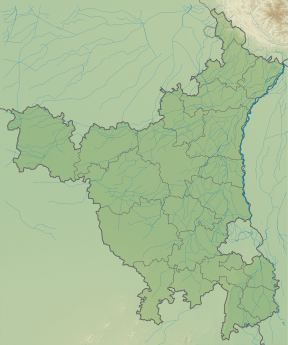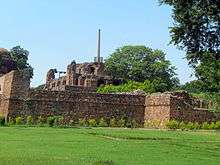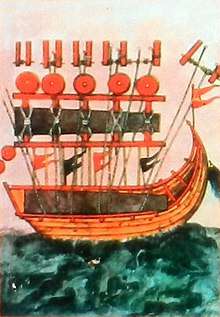Topra Kalan
Topra, combined name for the larger Topra Kalan and adjacent smaller Topra Khurd, is a Mauryan Empire-era village in Yamunanagar district of Harayana state in India.[1] It lies 14 km west of Yamunanagar, 14 km from Radaur and 90 km from Chandigarh.
Topra | |
|---|---|
village | |
 Topra Location in Haryana, India  Topra Topra (Haryana) | |
| Coordinates: 30.1252°N 77.1623°E | |
| Country | |
| State | Haryana |
| Founded by | Mauryan Empire |
| Languages | |
| • Official | Hindi |
| Time zone | UTC+5:30 (IST) |
| Vehicle registration | HR |
| Website | haryana |
| Part of a series on |
| Buddhism |
|---|
 |
|
|
|
Topra Ashokan Pillar


Situated in Pong valley of is the original home of Delhi-Topra Ashokan pillar, one of many pillars of Ashoka, that was moved from Topra to Feroz Shah Kotla in Delhi in 1356 CE by Firuz Shah Tughlaq (1309-1388 CE).

The original inscription on the Delhi-Topra Ashokan obelisk is primarily in Brahmi script but language was prakrit, with some Pali and Sanskrit added later. The inscription was successfully translated in 1837 by James Prinsep.[2] This and other ancient lats (pillars, obelisk) have earned Feroz Shah Tughlaq and Delhi Sultanate fame for its architectural patronage.[3]
The Sultanate had wanted to break and reuse the Ashokan pillar for a minaret. Feroz Shah Tuhglaq, however decided to erect it near the mosque instead. At the time of re-installation of the obelisk in Delhi, in 1356, no one knew the meaning of the script engraved in the stone.[4]
About five hundred years later, the script (Brahmi) was deciphered by James Prinsep in 1837 with help from scripts discovered on other pillars and tablets in South Asia.[2]
It was restored by the Raja Hindu Rao after the Revolt of 1857.
Translation
The inscription on the 3rd century pillar describe King Devanampiya Piyadasi's[5] policies and appeal to the people and future generations of the kingdom in matters of dharma (just, virtuous life), moral precepts and freedoms. Some extracts of the translation, per James Prinsep, are as follows:[2]
Among high roads, I have caused fig trees to be planted that they may be for shade to animals and men...
— -Inscription on Ashoka Pillar[2]
...And let these and others the most skillful in the sacred offices discreetly and respectfully use their most persuasive efforts, acting on the heart and eyes of the children, for the purposes of imparting enthusiasm and instruction in dharma (religion).
— -Inscription on Ashoka Pillar[2]
And whatsoever benevolent acts have been done by me, the same shall be prescribed as duties to the people who follow after me, and in this manner shall their influence and increase be manifest - by service to father and mother, by service to spiritual pastors, by respectful demeanor to the aged and full of years, by kindness to learned, to the orphan and destitute and servants and minstrel tribe.
— -Inscription on Ashoka Pillar[2]
And religion increaseth among men by two separate processes - by performance of religious offices, and by security against persecution. (...) And that religion may be free from the persecution of men, that it may increase through the absolute prohibition to put to death (any) living beings or sacrifice aught that draweth breath. For such an object is all this done, that it may endure to my sons and sons' sons - as long the sun and the moon shall last.
— -Inscription on Ashoka Pillar[2]
Let stone pillars be prepared and let this edict of dharma (religion) be engraven thereon, that it may endure unto the remotest ages.
— -Inscription on Ashoka Pillar, Translated by James Prinsep in 1837[2]
Topra Ashokan Edicts Archaeological Park and Museum
In 2015 April, Manohar Lal Khattar, the Chief Minister of Haryana, announced an allocation of INR 50 crore (INR 500 million) to build an Ashokan Edicts Archaeological Park at Topra Kalan village where seven Ashoka Pillars, eight Rock Edicts and other ancient structures of Mauryan Time will be constructed. It was all started back in 2011 when Sidhartha Gauri and Dr. Satyadeep Neil Gauri, Founders of The Buddhist Forum initiated the project of Topra Asoka Edicts Park along with INTACH, Gram Panchayat, Topra Kalan and other social organizations.[6][7][8] Village panchayat has given away 28 acres land for the construction of park, museum and monastery.[9]
See also
References
- Rural Housing Report for Financial year 2012-2013
- Prinsep, J (1837). "Interpretation of the most ancient of inscriptions on the pillar called lat of Feroz Shah, near Delhi, and of the Allahabad, Radhia and Mattiah pillar, or lat inscriptions which agree therewith". Journal of the Asiatic Society. 6: 600–609.
- William Jeffrey McKibben, The Monumental Pillars of Fīrūz Shāh Tughluq, Ars Orientalis, Vol. 24, (1994), pp. 105-118
- HM Elliot & John Dawson (1871), Tarikh I Ferozi Shahi - Records of Court Historian Sams-i-Siraj The History of India, as Told by Its Own Historians, Volume 3, Cornell University Archives, pp 352-353
- another name for Ashoka
- Khattar announces Rs100 cr to develop Saraswati, Topra Kalan, The Tribune, 11-Apr-2015
- Park for Ashoka stalled?, DNA India News, 7-Nov-2016
| Edicts of Ashoka (Ruled 269–232 BCE) | |||||
| Regnal years of Ashoka |
Type of Edict (and location of the inscriptions) |
Geographical location | |||
| Year 8 | End of the Kalinga war and conversion to the "Dharma" |  Udegolam Nittur Brahmagiri Jatinga Rajula Mandagiri Yerragudi Sasaram Barabar Kandahar (Greek and Aramaic) Kandahar Khalsi Ai Khanoum (Greek city) | |||
| Year 10[1] | Minor Rock Edicts | Related events: Visit to the Bodhi tree in Bodh Gaya Construction of the Mahabodhi Temple and Diamond throne in Bodh Gaya Predication throughout India. Dissenssions in the Sangha Third Buddhist Council In Indian language: Sohgaura inscription Erection of the Pillars of Ashoka | |||
| Kandahar Bilingual Rock Inscription (in Greek and Aramaic, Kandahar) | |||||
| Minor Rock Edicts in Aramaic: Laghman Inscription, Taxila inscription | |||||
| Year 11 and later | Minor Rock Edicts (n°1, n°2 and n°3) (Panguraria, Maski, Palkigundu and Gavimath, Bahapur/Srinivaspuri, Bairat, Ahraura, Gujarra, Sasaram, Rajula Mandagiri, Yerragudi, Udegolam, Nittur, Brahmagiri, Siddapur, Jatinga-Rameshwara) | ||||
| Year 12 and later[1] | Barabar Caves inscriptions | Major Rock Edicts | |||
| Minor Pillar Edicts | Major Rock Edicts in Greek: Edicts n°12-13 (Kandahar) Major Rock Edicts in Indian language: Edicts No.1 ~ No.14 (in Kharoshthi script: Shahbazgarhi, Mansehra Edicts (in Brahmi script: Kalsi, Girnar, Sopara, Sannati, Yerragudi, Delhi Edicts) Major Rock Edicts 1-10, 14, Separate Edicts 1&2: (Dhauli, Jaugada) | ||||
| Schism Edict, Queen's Edict (Sarnath Sanchi Allahabad) Lumbini inscription, Nigali Sagar inscription | |||||
| Year 26, 27 and later[1] |
Major Pillar Edicts | ||||
| In Indian language: Major Pillar Edicts No.1 ~ No.7 (Allahabad pillar Delhi pillar Topra Kalan Rampurva Lauria Nandangarh Lauriya-Araraj Amaravati) Derived inscriptions in Aramaic, on rock: | |||||